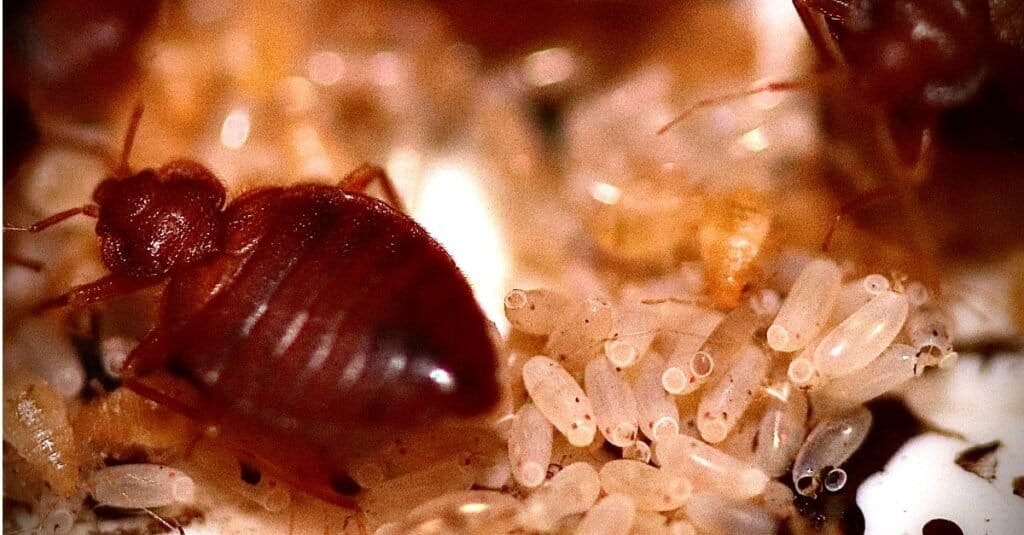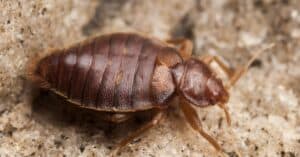Bed bugs are tiny parasitic insects that belong to the genus of Cimex. They come out at night to feed on human blood, which can cause painful bites and spread diseases. Once these annoying pests infest your home, they can be very difficult to eliminate, because they can survive for up to 70 days without feeding. They prefer to inhabit small secluded crevices such as cracks in the wall or seams in a mattress which can be difficult to reach with conventional tools. You can expect to spend a lot of time and/or money on the entire removal process. This article will cover some important facts about the identification, prevention, and treatment of bed bugs, both with and without an exterminator.
How to Identify Bed Bugs
Identification of the adult phase is fairly straightforward. The adult bed bugs are extremely small insects, measuring no more than a quarter of an inch long. They are characterized by a brown oval-shaped body with sharp puncturing suckers, a four-part antenna, and short hairs. When they feed on blood, their body inflates like a balloon and turns a reddish-brown color. The pre-adult phases, by contrast, look completely different. Nymphs have small, translucent white to yellowish bodies that make them very hard to see with the naked eye, while the pearly white eggs are about the same size as a pinhead. The eggs are marked by a prominent eyespot after about five days old.
If you suffer from an infestation, there’s a good chance you will feel the effects of the bed bugs before you actually see them. Red bites or blisters on the skin are the most common early signs of a bed bug infestation. These marks usually appear in one day, sometimes as little as just a few minutes. They can cause pain, itching, and even sometimes fatigue and fever because of the anticoagulant effects of the bed bug’s saliva. Rashes and hives can also occur after multiple bites. Exposed areas of the body such as arms, legs, face, and neck are most likely to be affected by bed bug bites. In some cases, however, symptoms may not appear at all, which can make identification more difficult.
If you suspect you’re dealing with an infestation, then one easy way to identify bed bugs is to purchase an at-home detector. The common chemicals to which they’re attracted, including carbon dioxide, lactic acid, and sex pheromones, act as a lure to trap the bugs in a container. This will confirm the presence of an infestation in your home. Once you’ve trapped the bed bug, you can either ID it yourself or take it to a professional. However, the lure is not necessarily an effective means of eradication, so don’t use it for that purpose.

©iStock.com/Matteo Lanciano
How to Get Rid of Bed Bugs
The first thing you need to do (whether you aim to proceed with or without an exterminator) is to clean out the infected area. You will need to remove all the clutter from the room where the bed bugs could be hiding. Do not move the items to another area of your home. This could just serve to spread the infestation. Instead, place the infested items in a plastic bag and then treat them with one of the methods listed in the next section. If the item cannot be treated, then you may have to let it sit for months at a time or just dispose of it completely (do not give it away to other people).
The next step is to eliminate the most common hiding spaces around the wall and bed. This will involve a long and difficult process. You should caulk any cracks or crevices around the baseboards; repair any damage to the walls, and check the electrical outlets for activity, and then tape or caulk the outside rim as needed. You should then move the bed at least 6 inches from the wall; replace your current covers with bed bug proof covers or liners; put bed bug interceptors under each leg of the bed; remove any objects from underneath the bed, and otherwise ensure there are no bed bugs lurking in a mattress. You should also vacuum the infected area and empty the bag after each use.
Once you’ve treated the items and cleaned out the infected area, you should continue to look for signs of a bed bug infestation every few days. If you spot signs of an infestation, then you may need to go through some of the treatment steps again. In order to save yourself time and effort, you may want to hire a pest control professional to take care of the problem for you. This is a more expensive option but also has a higher chance of success. You will still need to clean out the infected area before the full treatment, but a professional may have access to equipment and tools that are beyond the ability of the average consumer.
How to Treat Bed Bugs
This section will feature some important facts about how to treat infected items and eliminate bed bugs. Keep in mind you should always follow the safety instructions thoroughly. Some of these treatments could endanger you and your home if not properly followed.
- Cold Treatment: Place the affected items in a sealed back and leave them in the freezer for at least four days. Use a thermometer to make sure the temperature inside of the freezer is set to no more than zero degrees Fahrenheit (that’s -18 degrees Celsius).
- Heat Treatment: Bed bugs can be killed with the use of a portable heat chamber, a clothes dryer, or other instrument that produces enough heat.
- Steam Cleaners: Wet or dry steam cleaners set to least 130 degrees Fahrenheit can seep directly into cracks and fabrics, as well as the seams in a mattress, in order to get rid of bed bugs. A diffuser will prevent the bed bugs from scattering all over the place upon contact.
- Chemical Treatments: Pesticides should be used as a last resort once other options have proven to be inadequate. You should always look for EPA-approved products specifically tailored for bed bugs. Check the label for basic facts about the product, and never buy anything that hasn’t been thoroughly tested for consumer safety. Some chemicals may work as little as in one day. Dessicants (drying chemicals) may be particularly effective against bed bugs, but they can also take months to fully have an effect. Foggers should be used only with particular caution, because they can cause a fire or explosion. They are also unable to reach cracks and crevices where the bed bugs are most likely to be found.

©yurakrasil/Shutterstock.com
How to Prevent Bed Bugs
Unfortunately, there is no one simple trick for the prevention of bed bugs. Contrary to popular opinion, bed bugs are not necessarily attracted to places with poor hygiene. They do tend to be attracted to densely populated areas with lots of places to hide in, but any home can be affected. It’s all too easy to accidentally bring home bed bugs if you’re returning from a hotel room or lodging that also has an infestation. Clothing, bedding, and any other contents of a suitcase can be a potential vector for bed bugs. This means all objects entering the home should be inspected for an infestation and possibly even decontaminated fully before they’re used again. As mentioned previously, sealing up all holes and crevices in your home is also an excellent prevention measure. Always be vigilant for early signs of an infestation so you can stop it early and prevent it from spreading.
Next Up: Scaleless Snakes: Meet the Scaleless Ball Python, Scaleless Corn Snake, and More!
The photo featured at the top of this post is © iStock.com/John-Reynolds
FAQs (Frequently Asked Questions)
Do bed bugs go away on their own?
The bad news is that bed bugs will not necessarily go away on their own. They will continue to produce new eggs and feed on blood until you take steps to eliminate them.
What kills bed bugs instantly?
Pesticides and sprays will usually kill bed bugs almost instantaneously or at least in one day. However, these chemicals should be handled with extreme care. They can be a serious hazard if used improperly by making people sick or completely contaminating the home. A professional exterminator isn’t necessarily needed to use pesticides, but it will make things much easier.
How do you keep bed bugs from coming back?
Once you’ve cleared your home an infestation, there are some basic steps you can take even without an exterminator to ensure they don’t return. Bed bugs usually arrive through infected items from outside the home. This means you should always inspect them first for early signs of an infestation. If you’ve stayed the night in a hotel or lodging, or you’ve bought some used clothing or bedding, then you may be at greater risk of an infestation.
Thank you for reading! Have some feedback for us? Contact the AZ Animals editorial team.







